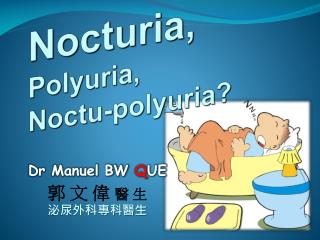

In the 6th decade of life there is a reversal of the trend described above the symptoms of nocturia are more commonly observed among men, which is probably associated mainly with the onset of prostate diseases. In addition, in women, more frequent occurrences of nocturia are observed during pregnancy and the postpartum period, as well as during the postmenopausal period.

Sex – the symptoms of nocturia are more common among women than men up until about the 6th decade of life. Among the group of people aged 65–74 years, the symptoms occur in up to 25% of the subjects. For adults aged ≤24 years the symptoms of clinically relevant nocturia (at least 2 micturitions during nighttime) are observed in less than 5% of the respondents, while that percentage increases to 15% in the 45–54 age group. The results of previous studies on nocturia have made it possible to distinguish factors that increase the risk of this symptom :Īge – numerous studies have unequivocally demonstrated that the risk of nocturia increases with age. The disturbance of the deep sleep phase has a significantly more negative impact on patients' health than waking up during the REM (Rapid Eye Movement) phase or during the shallow NREM phase. It has been observed that the most burdensome, due to the quality of sleep, are awakenings during the first 3–4 hours since falling asleep because they occur during the phase of deep sleep. Linear dependence was shown between the increase in the number of nocturia episodes and the subjective feelings of patients regarding their degree of nuisance. Based on the results of population studies, it is assumed that at least 2 micturitions during nighttime become a significant health problem because they substantially reduce the quality of life of the patients. Still under discussion are the reference values concerning the number of micturitions during nighttime, which are necessary for the diagnosis of nocturia. For the elderly, nocturia can be a cause of unfortunate accidents (including hard to heal fractures) that increase the mortality rate. Nocturia is a serious therapeutic problem due to its great impact on the quality of sleep, which in turn is unfavorably reflected in the physical and mental health of the people affected. Īccording to the International Continence Society (ICS) the term nocturia means the urge to pass urine during nighttime, when the micturition was preceded by sleep and immediately followed by night rest. The disability of the storage phase can be associated with symptoms such as: frequency, urgency, nocturia and urinary incontinence, which significantly decreases the quality of life of patients. Treatment with desmopressin can also be considered as a form of therapy added in people with an overactive bladder or benign prostatic hyperplasia, in which nocturia is a significant clinical problem. The use of desmopressin allows for the reduction in the number of nocturia episodes, as well as improves the overall quality of life and sleep. The pharmacological treatment of nocturia caused by nocturnal polyuria is based on the use of desmopressin at a daily single dose of 25 µg for women and 50 µg for men. Moderate physical exercise is also recommended. Nocturia therapy should begin with modifying dietary habits, including compliance with the fluid regimen, avoiding alcohol, coffee and tea. In addition, a possible ultrasound and/or cystoscopy may be conducted.

In laboratory tests, a urinalysis may be used, in particular cases a cytological analysis of urine sediment may be carried out. The physical examination, depending on the patient's gender, should include gynecological examination with pelvic organ prolapse assessment or prostate evaluation. Detailed medical history should include information concerning: lower urinary tract symptoms (including nocturia), underlying illnesses, urogenital disorders, previous surgeries and medications administered.


 0 kommentar(er)
0 kommentar(er)
